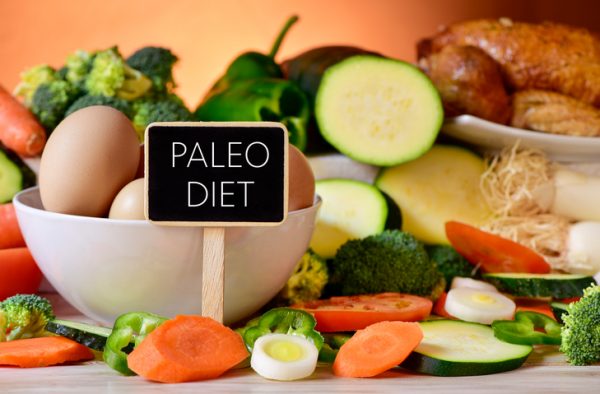Is eating Paleo how we used to eat?
Well, the answer to this question is yes and no.
The Paleolythic period started around 2.6 million years ago and ended 10 -15,000 years BC. Archaeologists believe the discovery of fire and the development of weapons, thought to be 1.8 million years ago, heralded the introduction of meat and cooked food into the diet. However, humans became bipedal (walking on two legs rather than four) 6 to 7 million years ago, so this leaves a rather inconvenient earlier time period during which we weren’t eating Paleo.
My interest in the Paleo diet was stimulated by a London conference on autoimmunity in 2007 presented by one of the scientists working with Dr Lorain Cordain at Colorado University. Dr Cordain is the world’s foremost authority on Paleo eating, and has published over 100 peer-reviewed scientific articles in top scientific journals such as the American Journal of Clinic Nutrition, the British Journal of Nutrition and the European Journal of Clinical Nutrition. Dr Cordain’s popular book, The Paleo Diet, has been widely acclaimed in the scientific community and he received the Scholarly Excellence Award for his contributions to nutrition.
There is no doubt that a significant number of people enjoy improved health and energy on the Paleo diet. The Paleo diet removes all processed, factory-farmed and non-organic foods, sugar, hybrid vegetables and fruits such as nightshades, grains, dairy, and legumes (beans and pulses). Legumes are inedible unless pre-soaked, sprouted or cooked. Nuts and seeds are kept to a minimum, as in Paleo times they would have been seasonal and they too contain enzyme inhibitors requiring prior soaking or sprouting.
Much of the success of the Paleo diet is likely to because of what it leaves out. The foods eliminated on the Paleo diet are the foods most subject to industrialised production processes, selective breeding and genetic modification. Modern meat is bred to be low fat, and unless organic, the animals would have been fed antibiotics (farm animals account for 80% of the world’s antibiotic prescriptions). Farm animals are also fed growth promoters and an unnatural diet that rarely includes grass, which substantially alters the nutrients and fats in the meat itself. We are now in the ridiculous situation where vegetable oils are found in some meats!
Likewise, modern wheat is completely different and more indigestible than the wheat eaten by our grandparents. Have you wondered why so many people are becoming gluten intolerant? Dairy is ultra-pasteurised and often homogenised, destroying much of the nutritional content and altering the proteins, which is the reason many people today are allergic to it. Nightshades (tomatoes, peppers, potatoes, aubergines, chillis) are avoided as they are comparatively recent introductions to the diet, with potatoes first being introduced around 500 years ago. For more information about the processing of foods and their effects on health please read my book Go Paleo – Feeding the Urban Caveman.
The Paleo diet is also sugar-free so blood sugar may (but not always) become more stable, although we have recently learned that high protein foods can destabilise blood sugar in the same way that sugar can. Since sugar kills immune cells, immunity may improve and inflammation is likely to decrease on the Paleo diet. And as the diet is organic, the detrimental effects of pesticides and glyphosate are also avoided. For most people, switching from bog standard supermarket fare to eating results in improvements in health. But is it sustained and is an improvement enough?
So, as you can see, the answer to the question Is the Paleo diet how we used to eat? needs qualifying. Firstly, it depends how far back in prehistory you go. Secondly, it depends on how you define a Paleo diet. I believe it is impossible not to let modern beliefs and prejudices about health obscure our judgement about the way our distant ancestors ate. To compound matters, Paleo eating has, in my view, mistakenly been assumed to have been high in protein. It has been hijacked by some parts of the fitness industry who recommend it for body building, and the low carb fraternity – who advocate replacing grains with protein – have seized on it as a weight loss diet.
But it is not easy to catch a wild animal, and it is even harder to preserve a carcass for any length of time without a fridge. (And can you imagine trying to milk a wild animal?) In my view, most of the protein obtained in Paleo times would have come from insects, rodents and foraged eggs with most of the calories obtained from carbohydrates provided by wild fruits and vegetables. (Wild fruits are not sweet like their modern counterparts.)
In addition, our Paleo forebears walked an average of 25 miles per day. They were not stuck behind a screen or the wheel of a car, but led physically active, outdoor lives requiring a high intake of fat and calories. A diet that fulfilled the needs of a physically active nomad would require significant modification to suit the modern urbanite – even if he is pumping iron down the gym.
So, as it isn’t possible to replicate the diet accurately, what passes for the Paleo diet today can never be more than a neo-Paleo diet. Although, a great improvement on the industrialised supermarket fare upon which most people rely for sustenance, whether the health advantages are sustained in everyone who follows it is questionable. And, of course, as with all diets, there will be some who feel worse on it. So, this brings us to personalised diets which we will explore in my next blog.



